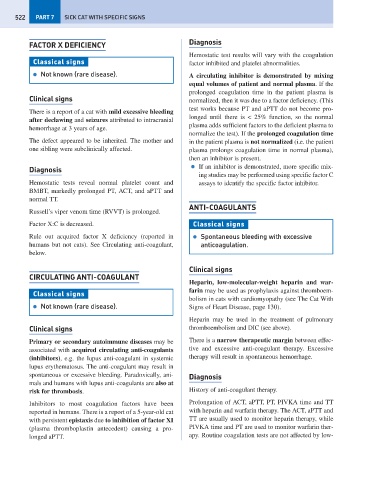Page 530 - Problem-Based Feline Medicine
P. 530
522 PART 7 SICK CAT WITH SPECIFIC SIGNS
FACTOR X DEFICIENCY Diagnosis
Hemostatic test results will vary with the coagulation
Classical signs factor inhibited and platelet abnormalities.
● Not known (rare disease). A circulating inhibitor is demonstrated by mixing
equal volumes of patient and normal plasma. If the
prolonged coagulation time in the patient plasma is
Clinical signs normalized, then it was due to a factor deficiency. (This
test works because PT and aPTT do not become pro-
There is a report of a cat with mild excessive bleeding
longed until there is < 25% function, so the normal
after declawing and seizures attributed to intracranial
plasma adds sufficient factors to the deficient plasma to
hemorrhage at 3 years of age.
normalize the test). If the prolonged coagulation time
The defect appeared to be inherited. The mother and in the patient plasma is not normalized (i.e. the patient
one sibling were subclinically affected. plasma prolongs coagulation time in normal plasma),
then an inhibitor is present.
● If an inhibitor is demonstrated, more specific mix-
Diagnosis
ing studies may be performed using specific factor C
Hemostatic tests reveal normal platelet count and assays to identify the specific factor inhibitor.
BMBT, markedly prolonged PT, ACT, and aPTT and
normal TT.
ANTI-COAGULANTS
Russell’s viper venom time (RVVT) is prolonged.
Factor X:C is decreased. Classical signs
Rule out acquired factor X deficiency (reported in ● Spontaneous bleeding with excessive
humans but not cats). See Circulating anti-coagulant, anticoagulation.
below.
Clinical signs
CIRCULATING ANTI-COAGULANT
Heparin, low-molecular-weight heparin and war-
farin may be used as prophylaxis against thromboem-
Classical signs
bolism in cats with cardiomyopathy (see The Cat With
● Not known (rare disease). Signs of Heart Disease, page 130).
Heparin may be used in the treatment of pulmonary
Clinical signs thromboembolism and DIC (see above).
Primary or secondary autoimmune diseases may be There is a narrow therapeutic margin between effec-
associated with acquired circulating anti-coagulants tive and excessive anti-coagulant therapy. Excessive
(inhibitors), e.g. the lupus anti-coagulant in systemic therapy will result in spontaneous hemorrhage.
lupus erythematosus. The anti-coagulant may result in
spontaneous or excessive bleeding. Paradoxically, ani- Diagnosis
mals and humans with lupus anti-coagulants are also at
risk for thrombosis. History of anti-coagulant therapy.
Inhibitors to most coagulation factors have been Prolongation of ACT, aPTT, PT, PIVKA time and TT
reported in humans. There is a report of a 5-year-old cat with heparin and warfarin therapy. The ACT, aPTT and
with persistent epistaxis due to inhibition of factor XI TT are usually used to monitor heparin therapy, while
(plasma thromboplastin antecedent) causing a pro- PIVKA time and PT are used to monitor warfarin ther-
longed aPTT. apy. Routine coagulation tests are not affected by low-

